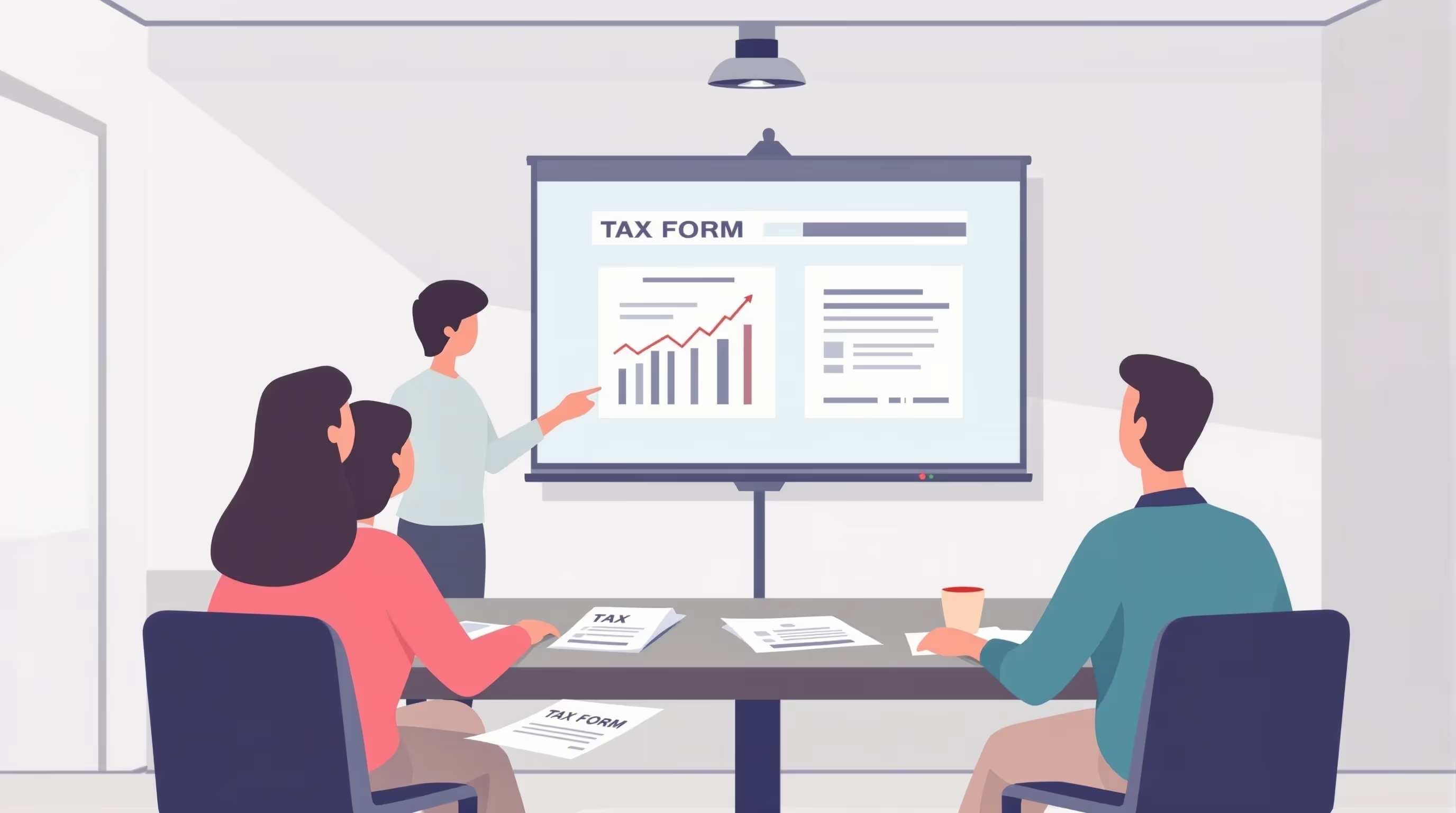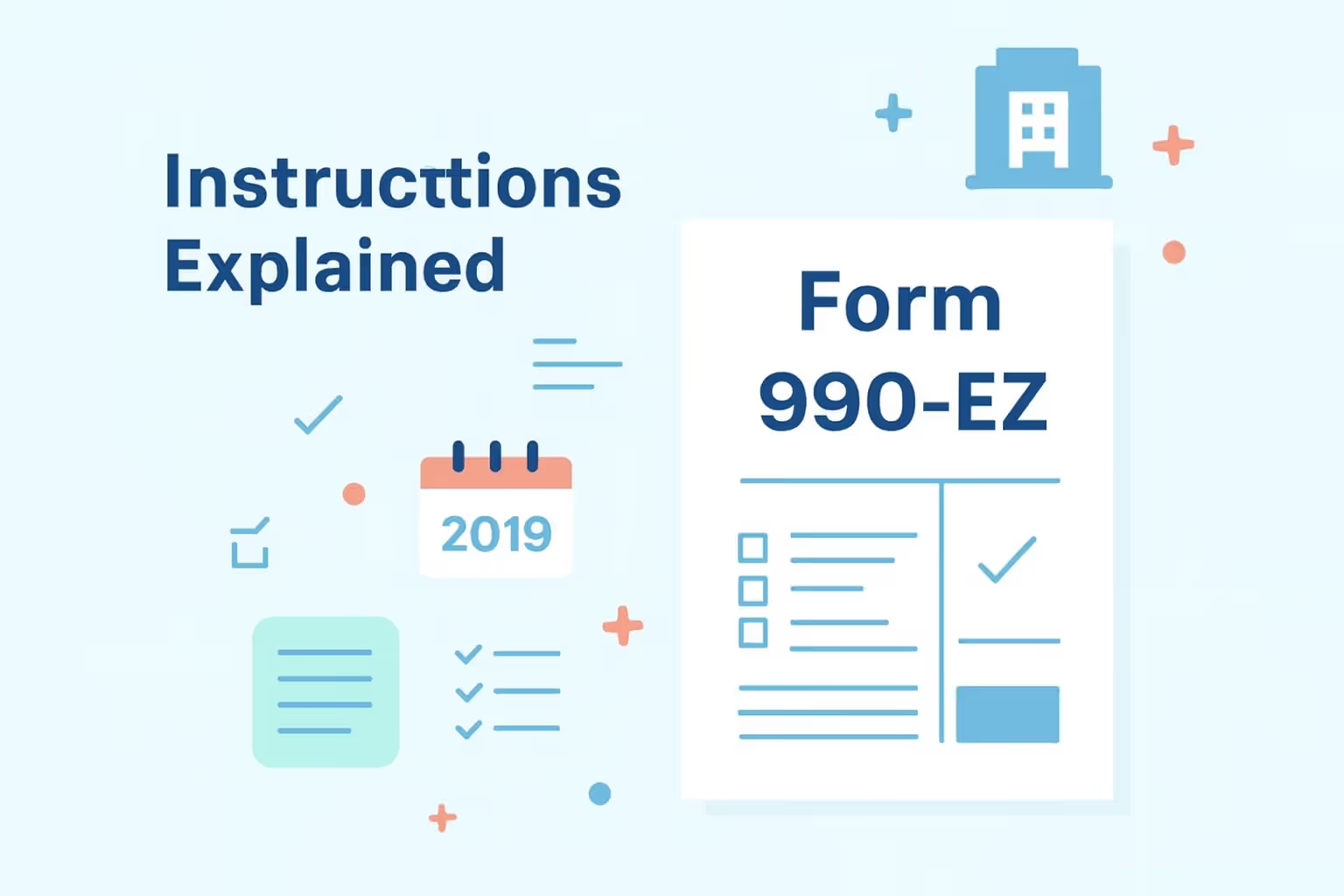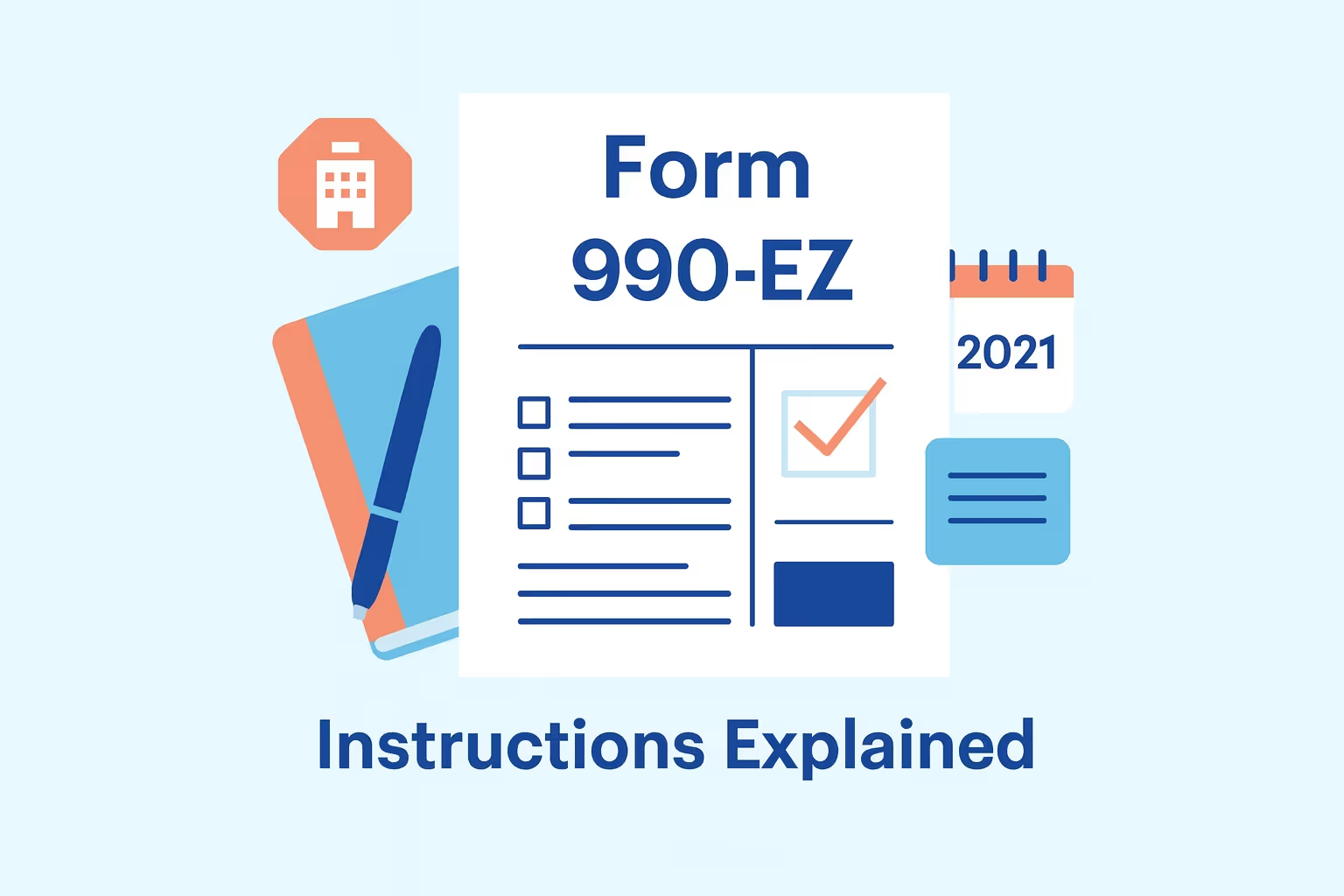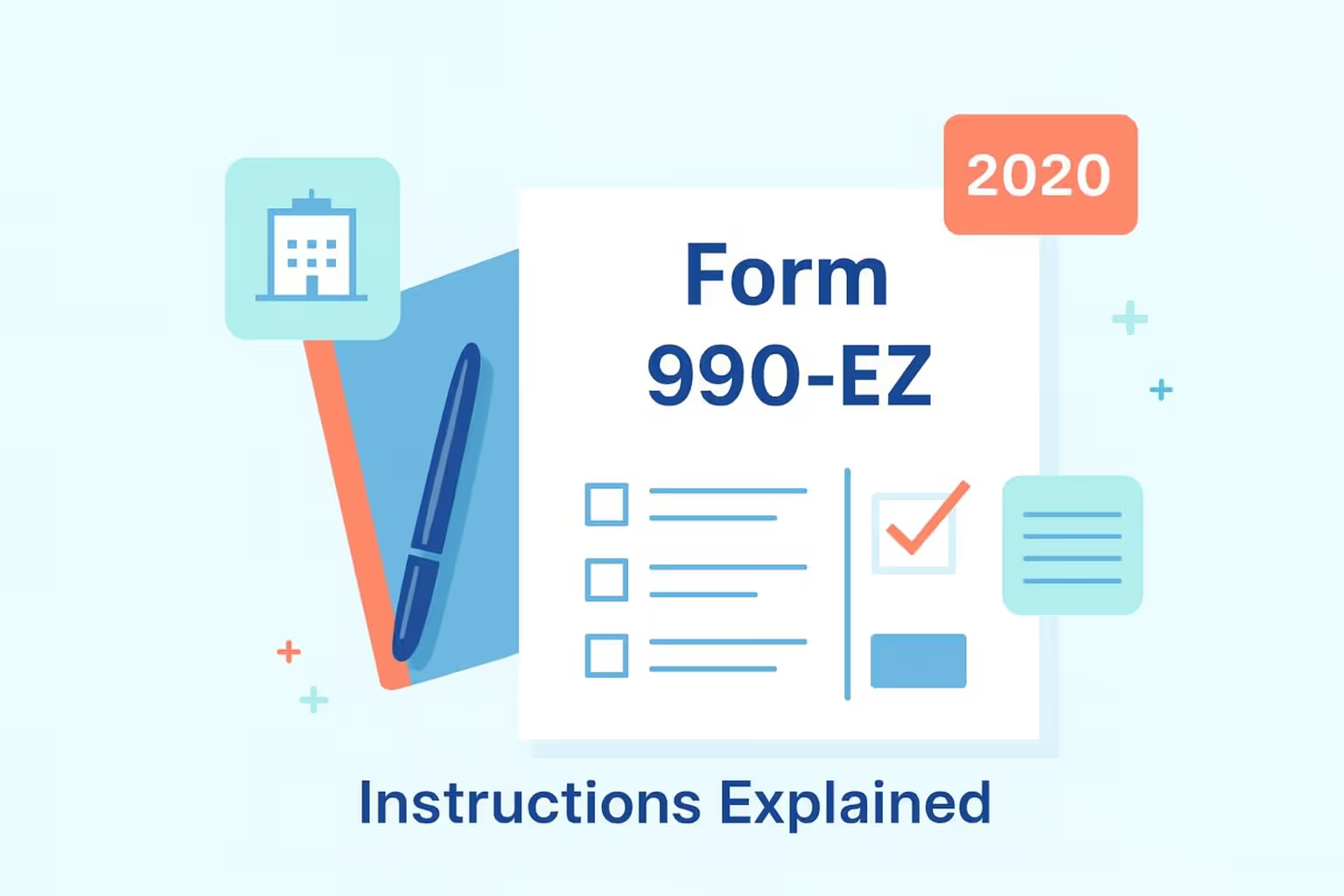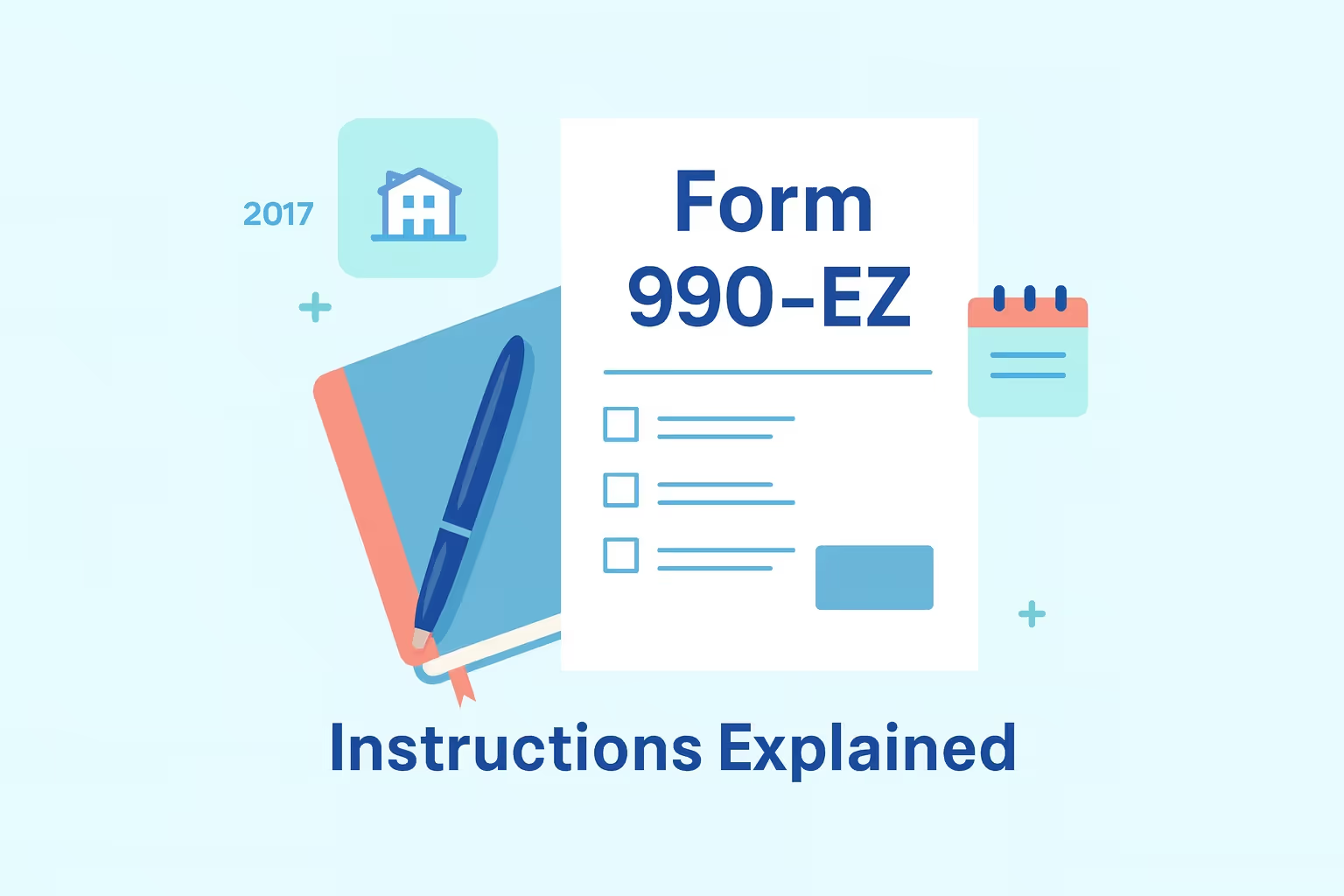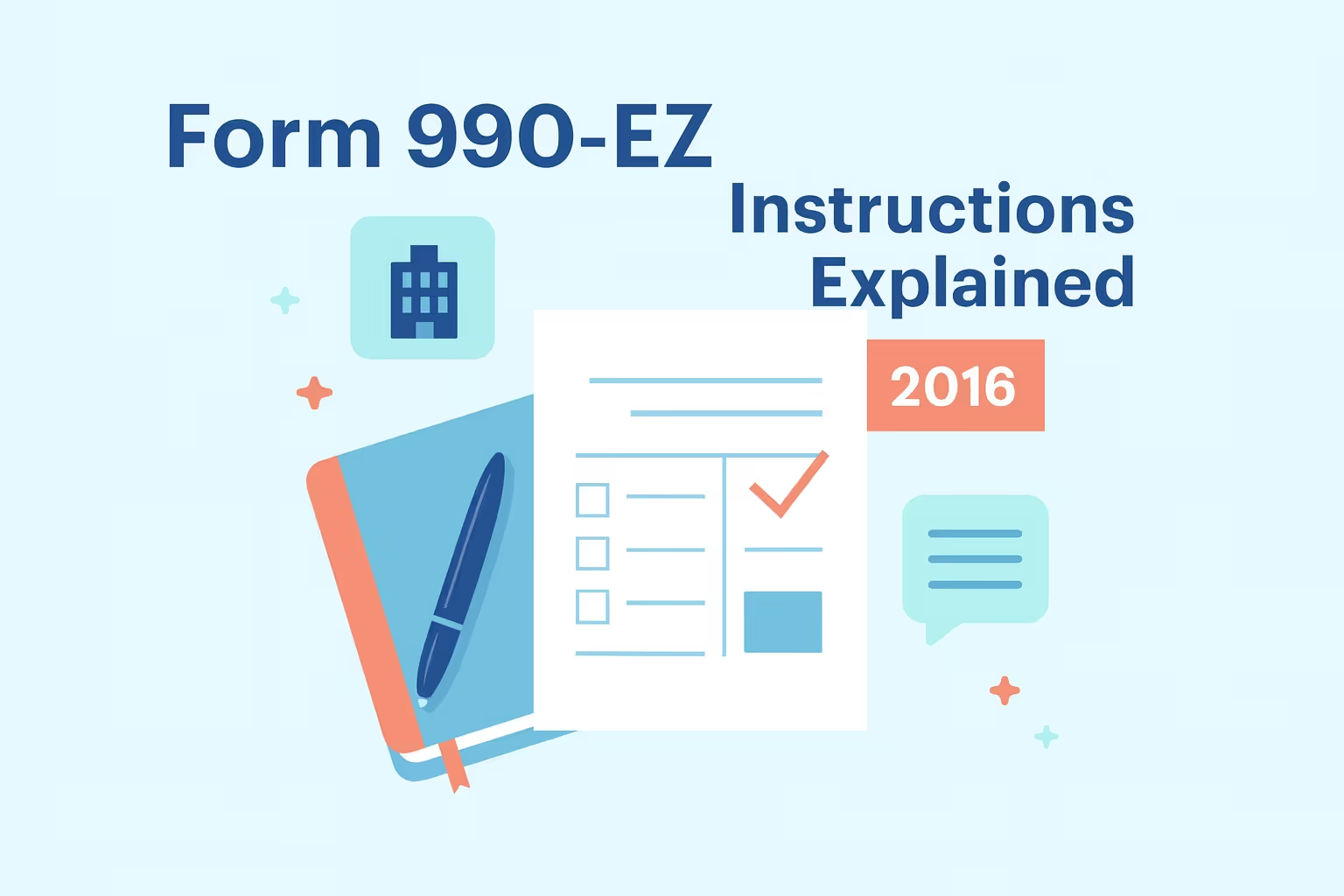How to File Federal Form 990-EZ for Tax Year 2023
Millions of nonprofit organizations must file with the IRS annually to maintain their tax-exempt status. Yet, many small and mid-sized groups struggle to complete their returns correctly, leading to late filings, penalties, or even revoked exemptions. According to the IRS, thousands of organizations lose their tax-exempt status annually simply for failing to file the proper return. Federal Form 990-EZ for Tax Year 2023 is the key to staying compliant for many smaller entities without unnecessary complexity.
Filing Form 990-EZ may look straightforward, but errors in reporting program service accomplishments, net assets, or income can quickly become costly. Mistakes like mismatched totals, incomplete organization details, or incorrect fiscal year entries often trigger processing delays or IRS inquiries. Filing late, even by a few days, can lead to penalties that grow monthly until corrected. These preventable issues can easily consume time and money that could otherwise go toward the organization’s mission.
This guide will walk you through how to file Federal Form 990-EZ for Tax Year 2023 step by step. You’ll learn which organizations qualify to use the form, what information to prepare before filing, and how to complete each section accurately. The goal is to help you avoid avoidable errors, maintain compliance, and maintain your organization’s public reputation. Whether you’re filing electronically or by mail, understanding these details will make the process smoother and less stressful.
Understanding Federal Form 990-EZ for Tax Year 2023
Filing the correct IRS form is crucial for maintaining your organization’s tax-exempt status. The Federal Form 990-EZ for Tax Year 2023 is specifically designed for smaller nonprofits, associations, and trusts that need a more straightforward way to report their annual financial activity. It balances the brief Form 990-N and the more detailed Form 990, allowing mid-sized organizations to meet compliance requirements without excessive paperwork.
What Is Form 990-EZ?
Form 990-EZ is a four-page version of the standard Form 990 used by tax-exempt organizations to report income, expenses, program service accomplishments, and changes in net assets. It provides transparency for donors, regulators, and the public by showing how funds are spent to achieve the organization’s primary exempt purpose. While the form is shorter, it covers vital sections, including program service revenue, expenses incurred, and balance sheet details.
Filing this form helps the IRS verify that your organization continues to operate for its stated charitable purpose. It also ensures compliance with the federal requirements for public charity status and nonprofit tax filing standards. Organizations that file the wrong form or omit key data risk penalties or revocation of exemption.
Who Should File Form 990-EZ?
Organizations that meet specific financial thresholds are eligible to use Form 990-EZ. Generally, it applies to entities with gross receipts under $200,000 and total assets below $500,000 at the end of the tax year. Examples include small public charities, educational nonprofits, and community associations. These organizations benefit from the simplified layout and reduced reporting requirements.
However, certain entities must use other forms. Private foundations typically file Form 990-PF, while larger organizations file the complete Form 990. Nonexempt charitable trusts and employee benefit plans may need to use Form 990-EZ depending on their income levels and organizational structure. Always confirm your eligibility before filing to avoid rejections or IRS penalties.
Why Accurate Filing Matters
Accurate filing goes beyond compliance; it protects your organization’s credibility. Reporting inconsistencies in total assets, net income, or program service accomplishments can prompt an IRS review or public concern. Incorrectly categorizing expenses or omitting key employees and officers may also violate reporting rules.
Errors can delay your acknowledgment of filing or lead to monetary penalties. Repeated inaccuracies can even result in the loss of tax-exempt status, subjecting the organization to regular income tax. Properly filing your Form 990-EZ demonstrates accountability and ensures that your donors and stakeholders maintain confidence in your operations.
Preparing to File Federal Form 990-EZ
Before filling out Federal Form 990-EZ for Tax Year 2023, gather every document and piece of financial information that supports your organization’s filing. Preparation ensures accuracy and prevents delays, especially when verifying your organization’s tax-exempt status or reporting program service revenue. Proper preparation also helps avoid errors affecting your standing as a public charity.
Gather Essential Information
To ensure a complete and accurate filing, collect the following details before beginning your return:
- Employer Identification Number (EIN): Verify that your EIN matches all filings from previous years. This number uniquely identifies your organization for income tax purposes and must remain consistent across all IRS forms.
- Organization Details: Confirm your legal name, address, telephone number, and fiscal tax year. Any change in your official information must be reported clearly on this year’s form to maintain consistent IRS records.
- Group Exemption Number (GEN): If your organization operates under a group ruling, confirm the GEN provided by the parent organization. Entering an incorrect number could result in a filing rejection.
- Program Service Accomplishments: Prepare summaries describing your organization’s main activities. Each activity should demonstrate how it fulfills your organization’s primary exempt purpose and how it generates program service revenue.
- Financial Statements: Gather your balance sheet, income statement, and details of all expenses incurred during the corresponding tax year. This includes salaries, grants, rent, utilities, and other compensation for employees and contractors.
- Supplemental Documentation: Prepare records related to gaming and fundraising events, foreign financial accounts, and any significant property dispositions. These documents will support transparency and compliance with IRS reporting standards.
Verify Eligibility and Requirements
Confirming your eligibility to file Form 990-EZ helps you avoid unnecessary corrections later. The IRS bases eligibility primarily on gross receipts and total assets.
- Form 990-N
- Gross Receipts: $50,000 or less
- Total Assets: Any amount
- Typical Filer Type: Tiny nonprofits
- Form 990-EZ
- Gross Receipts: Less than $200,000
- Total Assets: $500,000 or less
- Typical Filer Type: Small to medium tax-exempt organizations
- Form 990
- Gross Receipts: More than $200,000
- Total Assets: Over $500,000
- Typical Filer Type: Large organizations or private foundations
- Nonprofit organizations that fall within these financial limits can generally use Form 990-EZ. Always confirm these figures for your corresponding tax year, as thresholds may vary.
- Employee benefit plans and nonexempt charitable trusts should check IRS guidance to determine whether Form 990-EZ or another return applies to their structure.
- Organizations changing their fiscal tax year must report the previous and current periods to ensure the IRS records are correctly updated.
Once you have gathered your records and confirmed eligibility, the next step is completing each section of Federal Form 990-EZ accurately and in the correct order.
Filing Process and Submission Options
After completing Federal Form 990-EZ for Tax Year 2023, the final step is submitting it correctly to the IRS. Your filing method—electronic or paper—can significantly affect how quickly your return is processed and how soon you receive confirmation of acceptance. Choosing the proper submission method minimizes the risk of lost documents or data entry errors.
E-Filing vs. Paper Filing
The IRS strongly encourages e-filing because it offers faster processing, fewer errors, and an instant acknowledgment of receipt. In contrast, paper filings require manual review and can result in delays or misplaced documents.
- Electronic Filing: Filing online ensures your return reaches the IRS securely within minutes. Most electronic submissions receive an acknowledgment within 24 to 48 hours, confirming successful transmission. This option allows nonprofit organizations to track submission status directly through their e-filing provider.
- Paper Filing: Submitting a paper return involves printing, signing, and mailing the completed form to the IRS. Because paper forms must be entered manually, processing can take six to eight weeks. Organizations choosing this method should always use certified mail or a delivery service that provides tracking to confirm receipt.
- Choosing the Best Option: Although paper filing is still accepted, e-filing is generally recommended for accuracy and speed. The IRS’s online filing system reduces the risk of math errors and missing information, making it the preferred choice for most tax-exempt organizations.
How to File Online
Submitting Form 990-EZ electronically requires using an IRS-approved provider. These platforms are designed to guide you through each step and verify your entries before submission.
- Access the IRS Website: Visit the official IRS website and navigate to the Form 990-EZ section. Select one of the approved e-filing partners or platforms for your submission.
- Prepare and Upload Your Return: Use the IRS-compatible file format provided by the platform. Double-check all figures and ensure that organization details such as your EIN, fiscal tax year, and telephone number match prior filings.
- Review for Accuracy: Before final submission, verify that previously reported data aligns with current year totals. Errors in gross receipts, total assets, or the organization’s net assets can cause your return to be rejected or delayed.
- Submit the Return: Once verified, submit your completed form online. You should immediately receive an electronic acknowledgment of receipt confirming that the IRS has accepted your filing.
- Keep Your Confirmation Record: Save the acknowledgment email and submission confirmation number for your records. These documents provide proof of timely filing and can be invaluable in future disputes.
Payment and Penalties
Some organizations may need to make payments related to income tax, penalties, or other adjustments reported on Form 990-EZ. Understanding payment options and potential consequences for late submissions helps maintain compliance.
- Submitting Payments: If a balance is due, use the appropriate IRS payment method or voucher, such as Form 990-EZ-V. Payments can be made electronically through the IRS website or mailed with a check or money order.
- Failure-to-File Penalty: The IRS imposes a penalty of 5% of the unpaid monthly tax, up to a maximum of 25%, for organizations that fail to file by the due date. Filing even a few days late may trigger this charge.
- Failure-to-Pay Penalty: If taxes remain unpaid after filing, an additional penalty of 0.5% per month applies until the balance is settled. Interest continues to accrue on the unpaid portion.
- Impact on Tax Exempt Status: Repeated late filings or unpaid penalties can revoke an organization’s tax-exempt status. This change subjects the organization to regular income tax and may affect grants or public funding eligibility.
Filing your return is only part of the compliance process. Once your submission is complete, maintaining transparency and avoiding common filing errors are essential to keeping your organization in good standing.
Filing Process and Submission Options
After completing Federal Form 990-EZ for Tax Year 2023, the final step is submitting it correctly to the IRS. Your filing method—electronic or paper—can significantly affect how quickly your return is processed and how soon you receive confirmation of acceptance. Choosing the proper submission method minimizes the risk of lost documents or data entry errors.
E-Filing vs. Paper Filing
The IRS strongly encourages e-filing because it offers faster processing, fewer errors, and an instant acknowledgment of receipt. In contrast, paper filings require manual review and can result in delays or misplaced documents.
- Electronic Filing: Filing online ensures your return reaches the IRS securely within minutes. Most electronic submissions receive an acknowledgment within 24 to 48 hours, confirming successful transmission. This option allows nonprofit organizations to track submission status directly through their e-filing provider.
- Paper Filing: Submitting a paper return involves printing, signing, and mailing the completed form to the IRS. Because paper forms must be entered manually, processing can take six to eight weeks. Organizations choosing this method should always use certified mail or a delivery service that provides tracking to confirm receipt.
- Choosing the Best Option: Although paper filing is still accepted, e-filing is generally recommended for accuracy and speed. The IRS’s online filing system reduces the risk of math errors and missing information, making it the preferred choice for most tax-exempt organizations.
How to File Online
Submitting Form 990-EZ electronically requires using an IRS-approved provider. These platforms are designed to guide you through each step and verify your entries before submission.
- Access the IRS Website: Visit the official IRS website and navigate to the Form 990-EZ section. Select one of the approved e-filing partners or platforms for your submission.
- Prepare and Upload Your Return: Use the IRS-compatible file format provided by the platform. Double-check all figures and ensure that organization details such as your EIN, fiscal tax year, and telephone number match prior filings.
- Review for Accuracy: Before final submission, verify that previously reported data aligns with current year totals. Errors in gross receipts, total assets, or the organization’s net assets can cause your return to be rejected or delayed.
- Submit the Return: Once verified, submit your completed form online. You should immediately receive an electronic acknowledgment of receipt confirming that the IRS has accepted your filing.
- Keep Your Confirmation Record: Save the acknowledgment email and submission confirmation number for your records. These documents provide proof of timely filing and can be invaluable in future disputes.
Payment and Penalties
Some organizations may need to make payments related to income tax, penalties, or other adjustments reported on Form 990-EZ. Understanding payment options and potential consequences for late submissions helps maintain compliance.
- Submitting Payments: If a balance is due, use the appropriate IRS payment method or voucher, such as Form 990-EZ-V. Payments can be made electronically through the IRS website or mailed with a check or money order.
- Failure-to-File Penalty: The IRS imposes a penalty of 5% of the unpaid monthly tax, up to a maximum of 25%, for organizations that fail to file by the due date. Filing even a few days late may trigger this charge.
- Failure-to-Pay Penalty: If taxes remain unpaid after filing, an additional penalty of 0.5% per month applies until the balance is settled. Interest continues to accrue on the unpaid portion.
- Impact on Tax Exempt Status: Repeated late filings or unpaid penalties can revoke an organization’s tax-exempt status. This change subjects the organization to regular income tax and may affect grants or public funding eligibility.
Filing your return is only part of the compliance process. Once your submission is complete, maintaining transparency and avoiding common filing errors are essential to keeping your organization in good standing.
Compliance, Transparency, and Common Errors to Avoid
Filing Federal Form 990-EZ for Tax Year 2023 is only part of the compliance process. Maintaining transparency and accuracy after submission is equally essential. Errors or omissions can delay acceptance, lead to penalties, or jeopardize your organization’s tax-exempt status. Understanding common mistakes and following best practices ensures smoother filing and continued eligibility for public charity status.
Frequent Filing Mistakes
Even experienced organizations can make errors when completing Form 990-EZ. These mistakes often stem from oversight, misclassification, or inconsistent financial data.
- Omitting Required Schedules: Many organizations forget to attach schedules supporting their return. For example, missing Schedule A for public charity status verification or Schedule O for supplemental explanations can cause the IRS to reject your filing.
- Entering Inconsistent Totals: Discrepancies between your total assets, expenses incurred, and balance sheet figures may raise red flags. Always cross-check your financial statements to ensure they align with the numbers reported on the form.
- Using an Incorrect Employer Identification Number (EIN): The EIN must match prior filings exactly. Entering an incorrect or outdated EIN can delay processing or require re-filing.
- Failing to Report Key Employees or Interested Persons: Each organization must accurately disclose officers, directors, and the highest compensated employees. Omitting this information violates reporting requirements and can damage credibility.
- Ignoring Filing Deadlines: Late filings can trigger penalties and risk the loss of tax-exempt status after three consecutive missed years. Filing on time preserves compliance and prevents unnecessary fees.
Maintaining Transparency
Transparency is essential to public trust and IRS compliance. Every tax-exempt organization must clearly demonstrate how it uses its funds to achieve its exempt purpose.
- Document Program Service Accomplishments: Keep detailed records of all program service accomplishments, including measurable outcomes and community impact. These records support your entries in Section B of Form 990-EZ and reinforce your organization’s mission.
- Report All Forms of Support and Income: Disclose public support, capital contributions, and income from gaming and fundraising events. Honest reporting of all financial activity helps demonstrate your organization’s integrity.
- Maintain Records for Foreign Financial Accounts: If your organization holds or manages foreign accounts, ensure all related transactions are reported accurately. These details must appear in the supplemental section to maintain compliance with federal reporting rules.
- Provide Clarity on Lobbying or Political Activities: If your organization participates in lobbying activities or political campaign events, disclose these actions. While limited participation may be allowed, transparency ensures continued compliance with federal law.
Staying in Good Standing
After filing, your responsibility extends to maintaining compliance year-round. This includes accurate recordkeeping, communication with the IRS, and timely updates to organizational information.
- Keep Financial Records Organized: Maintain all receipts, bank statements, and ledgers for at least three years after filing. Organized records simplify future filings and make audits more straightforward to manage.
- Respond Promptly to IRS Notices: If the IRS contacts your organization with questions or requests for clarification, reply within the specified time frame. Delays can lead to penalties or enforcement actions.
- Stay Informed on IRS Updates: The IRS occasionally revises its forms and requirements. Visit the IRS website regularly or consult a tax professional to stay current with changes affecting tax-exempt organizations.
- Ensure Consistency in Future Filings: Always reconcile your current and previous years’ data to maintain a clear financial trail. Consistency shows transparency and reliability in your reporting.
FAQs
What is the difference between Form 990 and Form 990-EZ?
Form 990-EZ is a simplified version of the complete Form 990 designed for smaller tax-exempt organizations. It applies to groups with gross receipts under $200,000 and total assets under $500,000. While both forms report revenue, expenses, and program service accomplishments, Form 990-EZ reduces the reporting burden by excluding several detailed schedules required of larger organizations and private foundations.
Can I file Form 990-EZ electronically?
The IRS requires most tax-exempt organizations to file electronically using approved e-filing systems. Online filing ensures faster processing, immediate confirmation, and fewer math or formatting errors. Paper filing is allowed but takes much longer to process and risks mailing delays. E-filing is strongly recommended for all eligible organizations, including corporations, trusts, and associations, to ensure timely and accurate submission.
What happens if I file late?
Late filing can result in severe penalties. The IRS may charge 5% of the unpaid monthly tax, up to 25% of the total due. If an organization fails to file for three consecutive years, its tax-exempt status is automatically revoked. This means it becomes subject to income tax, and regaining exemption requires a new application and reinstatement process that can take months.
What information must be included in the balance sheet?
The balance sheet must include total assets, liabilities, and the organization’s net assets at the beginning and end of the tax year. Be sure to list fund balances, capital contributions, and any total expenses or income changes. These details provide a clear view of the organization’s financial position and help verify that reported amounts match the rest of the Form 990-EZ.
Can I amend a previously filed Form 990-EZ?
Yes, if you discover errors or omissions, you can amend your previously filed Form 990-EZ. Prepare a corrected version marked “Amended Return,” include any revised schedules, and explain the changes in supplemental information. Constantly update affected sections like program service revenue, net assets, or fund balances. Submitting accurate revisions helps maintain transparency and ensures your organization complies with IRS reporting requirements.










